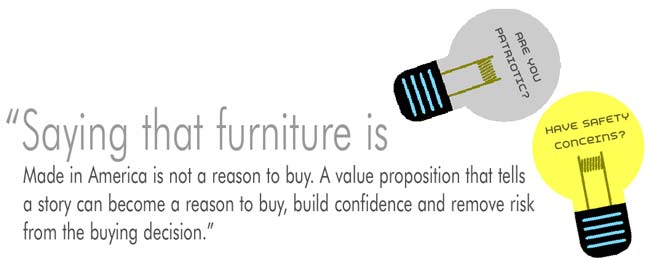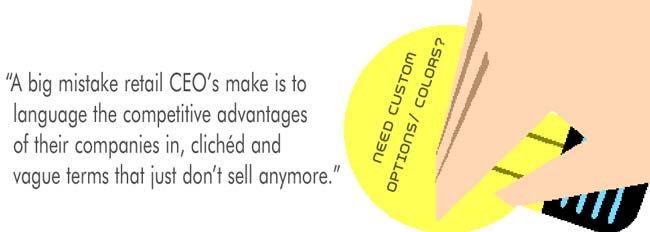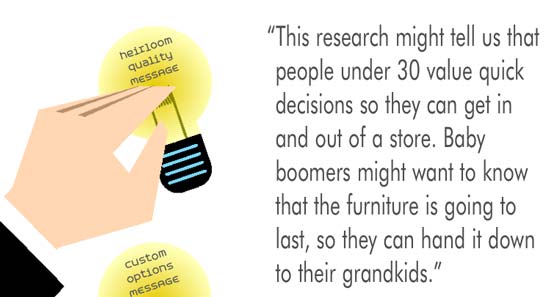According to a recent article in Consumer Reports, “Given a choice between a product made in the U.S. and an identical one made abroad, 78 percent of Americans would rather buy the American Product.” Consumers surveyed also noted that they would pay as much as 10 to 20 percent more for domestically sourced items.
The relationship between what people say motivates them, and how they act, is often tenuous. It can, therefore, be argued that some consumers who say they would pay 10% more for an “identical” piece, would be hard pressed to choose a $1200 table made domestically, over an identical $1,000 imported item. It’s easier for consumers to say they would pay 20% extra, than actually hand over $200 in grocery money.
Retailers interviewed for this article were, however, in general agreement that a high proportion of their shoppers are interested in domestically sourced furniture, and many pay a premium for the privilege of buying it. So, who are these customers? What are the best ways to reach them and sell to them?
To try to answer these questions, Furniture World interviewed Jaynie L. Smith, President of Smart Advantage, a management consultancy that helps businesses make their messages relevant by identifying targeted value propositions, to comment on what furniture retailers should consider when buying, marketing and selling domestically sourced, or for that matter, any home furnishings items.
The most important thing furniture retailers should do, she told us, “is to make sure that the products they stock are well received, not something they project customers will like. That’s a mistake that a lot of retailers make. They decide for themselves, without watching what the trends are. You have to be careful when you’re a specialist that you’re not projecting your taste or your views as a retailer on your customers instead of what they really desire,” she advises.

“Customers are not monolithic, and target markets buy for different reasons. “My second book, Relevant Selling, is about being relevant to the specific target you’re selling to.”
Do The Furniture Research
“Focus groups are good for idea generation. This qualitative research works well for testing out an idea or a brand name,” Smith continues. “I am more interested in quantitative research, primarily telephone surveys that result in data that is projectable, yielding a 90 percent confidence level with a margin of error of plus or minus 10 percent.
“This data can show how a customer chooses where to buy furniture, what kind of furniture they buy, why they buy it, and what they look for in addition to the product itself, whether it’s a knowledgeable sales person, or design help.”
In double blind research studies, Smith asks company executives, what they think their customers want the most. “Ninety percent guess wrong,” she relates. “Their sales and marketing are focused on attributes ‘A,B, and C’ when customers really want to hear about ‘D,E, and F’.” Smith says the best way for retail executives to avoid getting it wrong, is to propose and test number of possible value propositions. “If your store serves predominantly one demographic it’s easy, but there’s typically a combination of potential customers that should be surveyed by cohort,” she advises. “Cohorts are groups having well defined, ages, occupations or income levels.
“Just saying that furniture is Made in America may not be a reason to buy. A value proposition that includes information about using the finest hardwoods and joinery that will withstand 50 years of abuse, or telling a story about how a store delivers high rates of customer satisfaction can become a reason to buy, build confidence and remove risk from the buying decision.”

Know Your Cohort Groups:
Smart Advantage does research to discover what specific cohorts value most. “This research,” Smith explains, “might tell us that people under 30 value quick decisions so they can get in and out of a store. Baby boomers on the other hand might want to know that the furniture is going to last, so they can hand it down to their grandkids.” Once cohort information is gathered, the question becomes how to language messages to each group a retailer serves to get maximum results. Smith says part of the answer is to develop specific messages and then train salespeople to deliver them.
This segmented information lets sales and marketing people identify the approach that’s most likely to resonate with a target demographic such as a millennial or baby boomer. ”We develop cheat sheets so salespeople know what to say to each target market based on statistically valid, projectable research. Not every retailer can do this, and some won’t take the time,” she advises, “but the more laser focused your message and the more clearly defined the value proposition is to the person making the buying decision, the more you will sell and the further away from price as an objection you will get.”
Sales trainers often suggest sales associates rely on qualifying questions at the point of sale with open and close probes. That is clearly necessary, but the competitive advantage often comes from pre-qualifying. Furniture World asked Smith why using research to pre-qualify prospects can be so effective.
“Two reasons,” she replied. “One is people always tell you they want a good price because they’re negotiating. The double blind research we use, presents about 20 attributes individuals rank on a one to 10 scale, so we can gauge how important each of these are to them. It forces them to think about things that would not be top of mind. For example, we recently did some research for a window installation company, and found that getting the window measurement right was the top buying criteria. Not the window, the actual product, but getting the measurement right! So if the company could say that, ‘98.9 percent of the windows we’ve measured arrive perfectly measured, no re-dos.’ That might be a very good value proposition their customers would be willing to pay more for.”
The same might be true for a furniture retailer that specializes in domestically sourced home furnishings. If research shows that a subset of a retailer’s customers are primarily interested in design services to help create coordinated, beautiful homes. It might be a mistake for this retailer to focus sales presentations exclusively on delivering messages about lower ranked cohort interests such as construction features, custom options, fast delivery, safe manufacturing processes, fair wages, environmental issues, or job creation at home.
“Similarly,” Smith proposes, “if a cohort’s primary concern is to have a comfortable buying experience and be assured that a store will keep it’s promises, it might be wise to talk about customer satisfaction percentages backed up by thoughtful testimonials.
“Using research is vital to balancing the message. For example,” notes Smith, “There are stores that are very smart about putting whole rooms together so a group of people feel like the process is idiot proof. On the other hand, a group might feel like they’re getting cookie cutter solutions, so it’s helpful to know which customer will appreciate a pre-designed approach to furnishing a room and which are likely to want to personalize the design themselves.” The latter group may be more likely to value domestically sourced items that have more flexibility to design in custom options.
How To Avoid Commodity Status
Although promoting domestically sourced furniture can help to differentiate stores from a sea of sameness based on price and financing, many specialists who sell Made in America can improve how they language their offerings.
“A big mistake retail CEO’s make is to language the competitive advantages of their companies in clichéd and vague terms that just do not sell anymore,” advises Smith. “You cannot build a value proposition by saying ‘We have good customer service and good quality.’ So what? Everybody says that. It’s not going to get you anything! She says the most common examples of vague competitive advantages are: Good customer service, quality, reputation, good results, our employees, knowledgeable staff, consistent management, responsiveness, innovativeness and trust.

“Most retailers don’t know what to say about their own products, and that’s where they get into trouble with price. That’s why they need to make explicit information such as:
• What materials make the product a better value?
• What’s better about the product?
• What’s better about your delivery?
• What’s better about how you stand behind it?
• What’s better about how you make them feel good about buying it?
• Why should they buy from you and not the competition?
These are key points that very few businesses answer well, she concludes.”
Retailer Perspectives
One of the retailers interviewed for this article was Ed Smith, Founder, and President of Chariho furniture based in Richmond, RI.
Ed says his company has not done in-depth research of the type described by Jayne Smith, but does listen carefully to customers. For example, he’s noticed an uptick in consumer concern about the environment. “We do hear from more customers who are concerned about the lack of environmental controls in other countries, and these controls make products safer in the end.
“Our customers tend to be older, from their mid-forties to mid seventies. They can consider investing 10 or 12 thousand dollars on a bedroom set. We also serve a lot of veterans who want to buy something that's made in America versus China or Vietnam. They certainly want the dollars to go to America.
“We carry the upper end of the American made tier, so the price can be out of range of younger customers. If furniture isn’t English dovetailed, if it doesn't have choices, upon choices, upon choices, we don't put it in our store.
“Our single largest vendor is Harden Furniture and we do tons with Gat Creek, American Leather, DR Dimes, Copeland and Henkel Harris. We have over thirty Amish lines, the most meaningful ones being Simply Amish, Canal Dover, Country View Woodworking, Barkman, Millcraft and some smaller specialty Amish builders like Y&T Woodcraft and Wonderwood.”
Ed says that offering 100% American made furniture frees his salespeople from having to explain to customers, “which bedroom is made in Vietnam, which is China and which is made in America. If it's here, it's American made. It’s all we do.”
Chariho has always had success with a Made in America message, but a big boost to the category has come with the recent expansion of available styles. “We carry about thirty Amish lines. Twenty years ago when people thought of Amish style, they pictured an Oak roll top desk. Today these companies create awesome contemporary pieces in solid Walnut and natural Tiger Maple. There are great transitional and casual lifestyles as well. A lot of the American made manufacturers have stepped up to the plate.
Henry Yoder, the NIWA’s (Northern Indiana Woodcrafters Association) Representative and principal at RH Yoder Woodworking agrees. “We are seeing steady growth that’s due to more people warming up to the idea that Amish furniture is not just traditionally styled blonde Oak. Furniture retailers want domestically made products that really sell, so they are asking Amish builders to create the kinds of furniture styles they are looking for. But, there’s still some education that needs to be done to fully change perceptions.
“A big advantage of Made in America,” he notes, is that it can provide retailers with much shorter lead times from concept to execution of the actual piece. With domestic goods, and especially for Amish companies, it can be typically less than eight weeks from concept to finished product. There’s also the added advantage of having flexibility with specifying options and colors.”
Yoder mentioned, ”most of our customers are excited about quality, and it makes for a much easier sell. There’s a comfort level for furniture store owners and also retail salespeople who know they are working with a product that will result in high levels of customer satisfaction and fewer service issues.”
On the topic of promotional events and Amish furniture, Chariho Furniture’s Ed Smith adds that his, “single most successful event of the year, is an Amish themed event. For some reason, it gets people through the door and buying at a high average ticket. The difference between us and everybody else in our trading area is that carrying thirty lines gives us the ability to sell every single category in Amish furniture, be it a dining room set, youth furniture, bedroom, or a cedar chest and jewelry armoire.
“When customers pull up to our store,” he concludes, “they see a ten foot flag flying. Every piece of furniture has a Made in America hang tag. Our delivery drivers have jackets with a big embroidered American flag on the back. It’s the story that we talk about.”
Mark Fedde, President of California based Fedde Furniture has a different philosophy of how to promote his domestically sourced lines. There aren’t any red, white and blue flags flying. “We’ve been located in Pasadena, for 78 years, and have always tried to sell based on the quality of our furniture, he explains.”
Like Ed Smith at Chariho Furniture, Mark Fedde’s customers buy furniture that will last. “It’s an investment in a quality piece of furniture their grandkids will thank them for,” he explains.
“Our domestically sourced furniture includes some really nice import companies like Theodore Alexander and FFDM as well as domestic factories like Stickley Furniture and Simply Amish. Over the five to seven years, we’ve tried to swing a little bit towards the domestic side.
“Made in America is important and we do use it in our presentations,“ he told Furniture World. His signage, however, doesn’t shout Made in America. That’s because Fedde doesn’t feel that there is a benefit to identifying a country of origin for each piece of furniture in his store.
“The question then becomes,” he observes, “Where is this piece made, and where is that one made?” It’s a fact that many of the imported furniture lines we carry probably can’t be built domestically at the same values we offer. We are proud of our domestic offerings, but at the same time, just because a particular item is built in any one location doesn’t immediately make it a good or bad product.”
Fedde says that careful buying ensures that both his domestically and internationally sourced products have a high degree of quality, and he tries to work with factories that emphasize creating a partnership with their retailers, have good people, and focus on creating good communications with their factory people.
The Bottom Line
Asked about how telling a focused and consistent story has benefited Chariho Furniture, Ed Smith explains, “Throughout the whole recession all of my competitors were scrambling to bring in more imports at lower price points and thinking that was the answer. And, I just stayed the course. Did we feel the recession? Yeah, I actually had a year that we were down about three and a half percent. That was my worst year ever. Last year the business grew nine percent. I feel like we rebounded quicker because we never sent mixed messages.”
Ed says his people explain to customers the environmental and safety benefits of his domestically sourced furniture. “So they know that there are not going to be finishes or foams that are questionable. But what really drives it home, is that there are 310 million people living in the United States, and that if each would move 20 dollars a month spending from foreign made products to American made products, it would create five million jobs. We really talk up the economic benefits of buying American. They might pay 10 percent more or 20 percent more, but will be assured that it’s quality. We also articulate the message that if they buy a bedroom or dining set from Chairho, it will be the last one they ever need to buy.”
Additional information: More tips and tools to help you to successfully focus on domestically sourced products can be found in Furniture World’s March/April 2012 issue, “Plug In To Domestic: Sell More Made In America Furniture. It’s posted to the furninfo.com website at
https://www.furninfo.com/Furniture%20World%20Articles/260. That article gives specific ways to tell your story via website, social media, holiday promotion ideas, in store signage and sales presentations.
Russell Bienenstock is Editor-in-Chief of Furniture World Magazine, founded 1870. Comments can be directed to him at editor@furninfo.com.